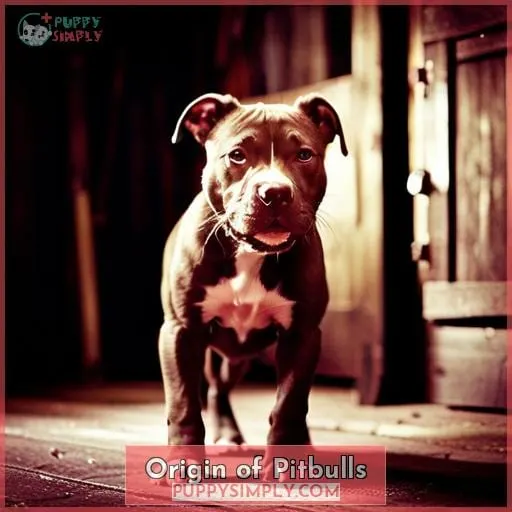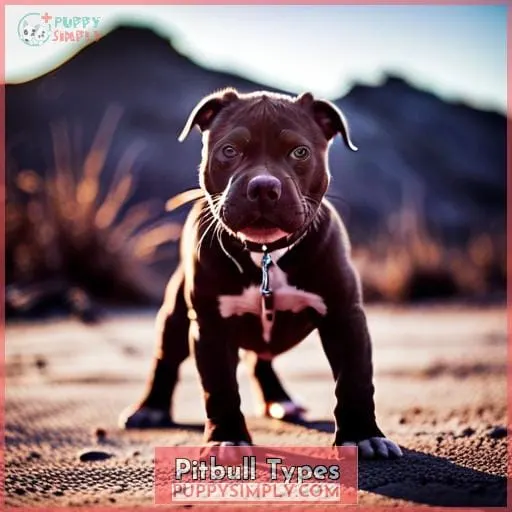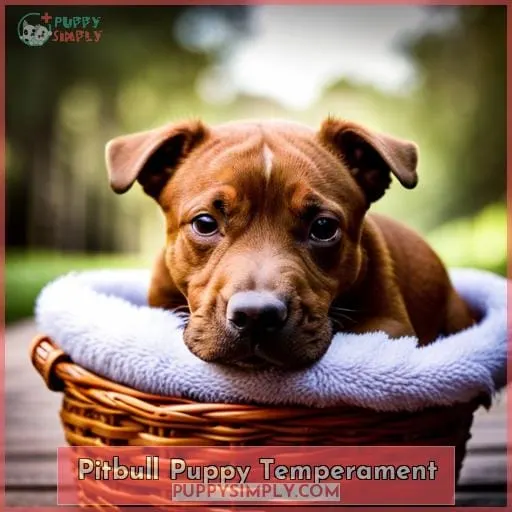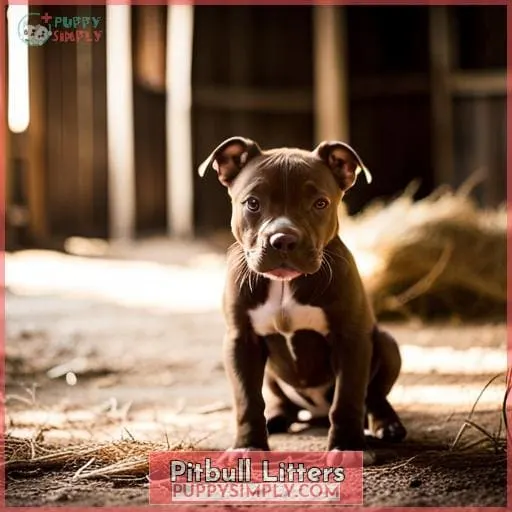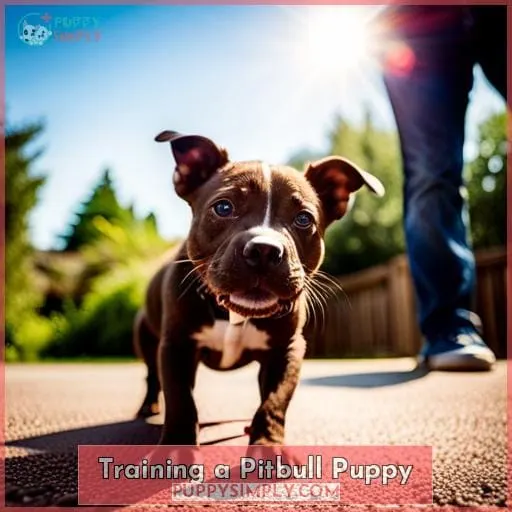This site is supported by our readers. We may earn a commission, at no cost to you, if you purchase through links.

As a prospective adopter, you want the facts to decide if one of these velvet hippos might fit your family.
Let’s peek behind the curtain at truths of the American Pit Bull Terrier’s history, care needs, and potential as a devoted companion.
Table Of Contents
- Key Takeaways
- Origin of Pitbulls
- Pitbull Types
- Pitbull Puppy Temperament
- Pitbull Puppy Size and Growth
- Grooming Needs
- Pitbull Litters
- Pitbulls as Family Dogs
- Are Pitbulls Dog Friendly?
- Training a Pitbull Puppy
- Pitbull Health and Care
- Frequently Asked Questions (FAQs)
- What types of toys and activities are best for Pit Bull puppies?
- How much exercise does an American Pit Bull Terrier puppy need each day?
- What health issues are common in Pit Bull puppyhood and how can they be prevented?
- What is the best way to socialize an American Pit Bull Terrier puppy?
- What training methods work best for teaching Pit Bull puppies basic obedience commands?
- Conclusion
Key Takeaways
- Rapid growth in first year, gaining up to 90 pounds, needing a high-quality diet and plenty of exercise
- Confident, loving, protective temperament requiring consistent training and early socialization
- Playful stubbornness and a strong urge for affection demanding patience and proper care
- Grooming needs like daily brushing and weekly ear cleaning to nurture health and gentle spirit
Origin of Pitbulls
You’re looking at a breed that originated in 19th century Britain when bulldog and terrier breeds were crossed for the purposes of bull baiting and dog fighting.
As cultural attitudes shifted, these blood sports were outlawed, leaving the pit bull without an outlet for its breeding.
Through immigration, the breed made its way to America, where it was embraced for its loyalty, athleticism, and tenacity.
However, the pit bull’s origins and formidable physique cast a shadow, subjecting it to breed-specific legislation, media vilification, and the stigma of being bred for violence.
Proper socialization, training, and responsible ownership are key to nurturing the pit bull’s gentle spirit and winning over a skeptical public.
When positively channeled, the breed’s strength and determination make it an ideal working dog and devoted family companion.
Pitbull Types
There are a few different Pitbull breeds to be aware of:
- The American Pitbull Terrier
- Staffordshire Bull Terrier
- American Staffordshire Bull Terrier
Each breed has its own distinct characteristics, so make sure you research the differences if you’re considering getting a Pitbull puppy.
American Pitbull Terrier
The American Pit BullTerrier is one of the most common Pit bull types seen in the United States today.
If you’re considering this breed for your family, you’ll want to understand their history, characteristics, and temperament:
- Originated in England for bull-baiting and dog fighting before becoming popular in America as farm dogs.
- Very muscular, stocky build with a broad head and strong jaws.
- Energetic, loyal, and trainable when properly socialized from a young age.
- Require consistent training and plenty of exercise to prevent boredom and destructive behaviors.
With proper care, they make wonderful family companions.
Staffordshire Bull Terrier
From the American Pitbull Terrier, let’s move on to the Staffordshire Bull Terrier, which is another type of pitbull puppy you’re likely to encounter.
Though smaller in stature than some other pitbull breeds, the Staffordshire Bull Terrier puppy retains the muscular build and loyal temperament pitbulls are known for, while also being exceptionally patient with children.
Despite their smaller size, Staffordshire Bull Terriers still need plenty of exercise and training to stay happy and healthy.
Their affectionate, people-focused nature makes them a loyal companion when properly socialized and trained.
American Staffordshire Bull Terrier
After the Staffordshire Bull Terrier, you’re gonna find the American Staffordshire Bull Terrier.
It is a larger, athletic, and loyal Pitbull type with its trademark pointed ears.
- Has a controversial history linked to dog fighting and aggression despite efforts to rebrand the breed.
- Intelligent and eager to please but requires consistent training and socialization.
- Originated in the 19th century when bulldog and terrier breeds were crossed for dog fighting.
- Needs at least an hour of vigorous daily exercise to prevent boredom and destructive behavior.
- Can be stubborn yet aims to follow commands when properly motivated through positive reinforcement.
Pitbull Puppy Temperament
You’ll find an American Pit Bull Terrier puppy to be a confident and stubborn dog with a loving, people-pleasing, and protective temperament.
Their confidence often borders playful assertiveness, as they eagerly seek companionship.
Loyal to a fault, they yearn to protect their family while demanding affection.
Socialization challenges stem from their stubbornness, so early exposure to people and animals prevents unwanted aggression.
Proper care cultivates their loving natures, curbing their natural tendencies toward possessiveness.
With compassion and consistency, you’ll experience the joys of their wholehearted devotion.
Though headstrong, their affectionate stubbornness makes them ideal companions if properly nurtured.
Pitbull Puppy Size and Growth
You’d be reaching full size by 12-18 months as pitbulls rapidly put on 30-90 pounds.
Your pitbull puppy’s growth isn’t linear. It’s best to keep an eye on your puppy’s size milestones.
Puppies grow rapidly, gaining up to 3 pounds per week. By 6 months, you’ll be about two-thirds of your adult size.
Your puppy’s nutritional needs are unique. You must be fed a high-quality diet that meets your specific needs.
An active lifestyle is also essential for your healthy development. Daily exercise will help you maintain a healthy weight and keep your muscles and bones strong.
Grooming Needs
As your rambunctious pit bull pup grows rapidly, attending to basic grooming will ensure good health.
Establish a thorough, yet gentle grooming routine early.
Brushing Basics:
- Daily brushing prevents shedding fur from coating your floors and furniture.
Nail Care:
- Regular trimming curtails painful scratches.
Clean Ears:
- Clean ears weekly with cotton balls and cleaner to prevent infections.
Bathing Tips:
- Gentle shampooing monthly, dry thoroughly afterward to avoid skin irritation.
Check the skin folds and coat during grooming for any unusual bumps, rashes, redness, or irritation.
Attending to these simple grooming needs will keep your American Pit Bull Terrier puppy clean, comfortable, and let you monitor health as you raise a happy, well-adjusted dog.
Pitbull Litters
Although pitbull females tend to have smaller litters, you’ll often see between 2 to 10 puppies when their litters arrive.
As a responsible pitbull owner, you should be aware of litter dynamics to provide proper care.
Consider the breeder’s practices regarding socialization and health monitoring from birth.
Once adopted into your home, continue positive socialization and training for these naturally strong-willed puppies.
Provide proper veterinary care to monitor for potential health issues like hip dysplasia.
With dedication to their complex needs, an American Pit Bull Terrier puppy can grow into a loyal companion.
As their caregiver, you must commit to understanding the breed’s temperament, health, and dietary requirements to raise a well-rounded pitbull.
Pitbulls as Family Dogs
You’ve found that when properly trained and socialized, your American Pit Bull Terrier makes an excellent family companion.
Despite common misconceptions, pitbulls thrive in a loving family environment.
Ensure all family members participate in training and reinforce positive behaviors.
Continue socialization to curb any stubbornness.
Schedule regular vet visits and purchase health insurance to stay atop any emerging conditions.
With time and effort, your American Pit Bull Terrier will likely mesh seamlessly into family dynamics, offering companionship and protection for years to come.
Are Pitbulls Dog Friendly?
Their reputation precedes them, but you’ve likely heard mixed reviews on whether pitbulls play nice with other dogs.
Pitbulls are extremely playful and affectionate dogs that can form close companionships with other canines when properly socialized from a young age.
Key socialization tips include early and frequent positive interactions with other friendly dogs to establish good experiences and behaviors.
Their energetic and excitable temperament means canine compatibility requires adequate outlets like playtime and walks to prevent frustration.
Despite myths, pitbulls aren’t inherently aggressive towards other dogs and their behavior largely stems from responsible ownership and training.
With proper care as puppies, they can become wonderful playful companions around people and other dogs alike.
Training a Pitbull Puppy
When training your Pitbull puppy, begin socialization and obedience training early to curb their tendency toward stubbornness.
Introduce them to new people, dogs, places, and experiences in a calm and positive way during the critical socialization period between 3-12 weeks old.
Use positive reinforcement like treats and praise to reward good behavior.
Attend puppy obedience classes for structured training.
Work on basic commands like sit, stay, come.
Be firm, consistent, and patient with training to establish yourself as pack leader.
Pitbulls crave attention and activity, so provide plenty of playtime and walks to prevent boredom and destructive behaviors.
Incorporate mental stimulation with interactive toys and games.
Proper socialization and training will ensure your Pitbull puppy grows into a happy, well-adjusted, loyal companion.
Socialization Techniques:
- Introduce new people
- Dog park visits
- Car rides
- Urban sounds
Grooming handling
Obedience Training:
- Sit, stay, come commands
- Loose leash walking
- Drop it command
- Impulse control games
Crate training
Playtime Activities:
- Tug of war
- Fetch
- Agility equipment
- Snuffle mats
- Food puzzles
Pitbull Health and Care
Specific aspects of preventive care and monitoring are essential for ensuring your American Pit Bull Terrier puppy grows into a healthy, happy adult dog.
Establish regular vet checkups starting as a pup:
- Monitor growth.
- Administer preventative care like vaccines.
- Test for health issues.
- Provide dietary guidelines.
- Answer questions.
Follow veterinary recommendations for spay/neuter around six months old.
Provide a nutritious diet:
- High in protein and fat for muscle development.
- Appropriate calcium for bone growth.
Establish an exercise routine:
- Daily walks.
- Play time.
- Behavioral training for mental stimulation.
Start early, consistent training to support good behavior and manners.
With proper preventive vet care, diet, exercise, and early training, your American Pit Bull Terrier will likely enjoy good health and a long, happy life as part of your family.
Frequently Asked Questions (FAQs)
What types of toys and activities are best for Pit Bull puppies?
Tough, durable chew toys and rope toys are ideal to satisfy their desire to chew.
High energy games like fetch, tug-of-war, and flirt pole allow them to release pent-up energy.
Training exercises also engage their minds.
Take care not to overexercise puppies while their joints are still developing.
How much exercise does an American Pit Bull Terrier puppy need each day?
As puppies, Pit Bulls need at least 30 to 45 minutes of vigorous exercise daily.
This is to expend their high energy, prevent boredom behaviors, and support healthy development.
Engage them in activities like fetching, tugging, running, and supervised playtime with other puppies.
What health issues are common in Pit Bull puppyhood and how can they be prevented?
Pit Bull puppies: robust, playful, prone to puppyhood ailments.
Prevent woes with:
- Balanced diet
- Ample exercise
- Regular vet visits
Vigilance ensures a healthy, happy canine companion.
What is the best way to socialize an American Pit Bull Terrier puppy?
Socialize your Pit Bull puppy early and often.
Introduce them positively to many people, environments, and dogs starting at 8 weeks old.
Reward calm, friendly behavior.
Sign up for puppy socialization classes.
Consistent socialization builds their confidence to be gentle companions.
What training methods work best for teaching Pit Bull puppies basic obedience commands?
With positive reinforcement and consistent training, you can teach your Pit Bull puppy basic obedience commands.
Reward desired behaviors with treats, praise, and affection to encourage learning.
Conclusion
When your family extends to four legs instead of two, only the highest companion for longevity comes into question.
The American Pit Bull Terrier overflows with unparalleled fidelity once boundaries and socialization start as early as 8 weeks old.
As the facts relay, proper nurturing of an American Pit Bull Terrier puppy sets the stage for a lifetime friend whose gentle temper and eagerness to please stand as tall as their sturdy frames.
Welcome an American Pit Bull Terrier into your home for devoted years overflowing with tail wags and slobbery kisses.

